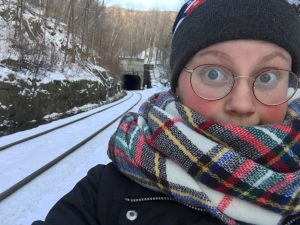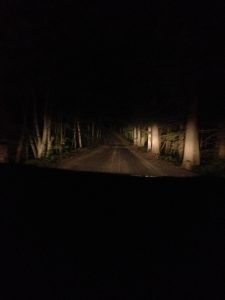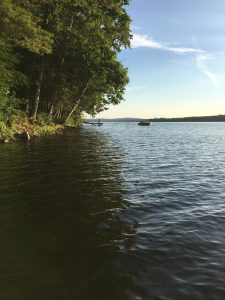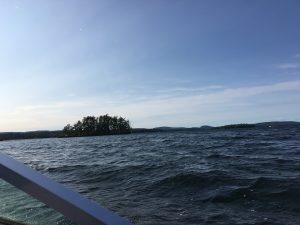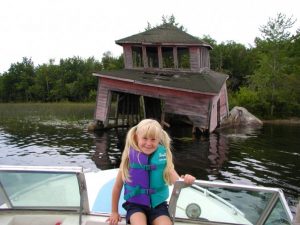Before this class I never would have actively thought about the process of nature writing, especially in terms of using digital tools. In the past, any nature writing I had done was for class assignments. While this was indeed a class, but this course made me think deeply about it and how we interact with the spaces around us.
In class we discussed how nature writing can occur in places such as bustling cities. The idea originally blew my mind. I had some difficulty seeing a place such as the Hoosac Tunnel as a place where nature writing can occur. But here I was, stepping forward suggesting it as a possible project of focus. And I wasn’t ready for this space to make the impact that it did.
Before this class, having any of my work visible to the rest of class would make me anxious, but in Storied Landscapes I knew my work would be on full display for not only my classmates, but anyone else who stumbles across it. This course gave me the confidence that I lacked in my writing, and my nature writing, and encouraged my creativity behind it.
Focusing on the Hoosac Tunnel has been an adventure. At first, I was confused about the course. I didn’t know what to expect or what I would be doing, or if I could even do it. Thinking about designing a website made me nervous because it was not something that I was familiar with.
Getting information on the Hoosac Tunnel proved to be difficult in the beginning. We do not have an archivist on campus so we had to go to the public library. Unfortunately, that means that we were not allowed to search through the material on our own. The process: ask, and hope there is something. So we asked. And we were handed a single book on the Hoosac Tunnel. We thought that maybe this was all that we would have to work with. It was hard to care about the project when there was nothing to work with. And our other option for a location that we could visit, was equally as difficult in regards to the information that was in the vault. It was hard, and it was frustrating.
Frustrated, we went back and asked the reference librarian if there was anything at all in the vault (the archive). This time, we had a different response. We were told there was “too much”– “too much” to pull. Since we were not allowed in the vault to sift through all of the material, we were directed to an online database that holds all of the information. We had a new problem: we suddenly had too much information. What was it that we were supposed to do with all of this information?
Unfortunately, by the time we were directed to the website, and by the time we were finding things we could do, we were excited with all the options we suddenly had before us. But what we didn’t have: was time. With this set back we were not able to do everything that we really hoped we would do for this project. We had so many brilliant, if I do say so myself, ideas that we simply no longer had the time to do. Our time cut sort by snowstorms and rain on the only days the two of us were able to get down to the space.
I thoroughly enjoyed being a part of the Storied Landscapes class this semester and can proudly say that through this class and some amazing teamwork, Erica and I have been able to create our Hoosac Tunnel site regardless of these roadblocks and plan to continue working on it past this semester. I am still very happy with the way the site has turned out by the end of this course and I’m excited to see it grow in the future. Having Professor Cooper and Professor Wiebe as the course leaders has been a blessing. They both were supportive and ready to help anyone in the class. Without Leah’s help I’m not sure I would have been able to even get this blog up and running.
This class has helped me developed skills that I didn’t realize I needed until I learned them and suddenly, so many doors have opened because of the skills I have under my belt. If I weren’t graduating I would have loved to take another COPLAC course.

 We took a couple time lapse videos to see what the result would look like and moved on to the tunnel. Carefully, we weaved our way around the mud and pointed out all the things we missed when there was more snow: the clear stream to our right, the depth of the stream to the left of the tracks, and all the rocks I naturally tripped over every few feet. And this time when we neared the West Portal: “Hey demons!” To be completely honest I have been completely absorbed with all things… spooky… lately and this time I was ready for something to scare me. This trip wasn’t made for that purpose but I was ready. I lost count of how many times I said, “What was that? What that the demons?” “I think it was a bird–” Erica (the logical one). Ghosts or spirits would have been the proper name but I was lost in the world of memes that particular morning and kept reciting them throughout the trip (sorry Erica).
We took a couple time lapse videos to see what the result would look like and moved on to the tunnel. Carefully, we weaved our way around the mud and pointed out all the things we missed when there was more snow: the clear stream to our right, the depth of the stream to the left of the tracks, and all the rocks I naturally tripped over every few feet. And this time when we neared the West Portal: “Hey demons!” To be completely honest I have been completely absorbed with all things… spooky… lately and this time I was ready for something to scare me. This trip wasn’t made for that purpose but I was ready. I lost count of how many times I said, “What was that? What that the demons?” “I think it was a bird–” Erica (the logical one). Ghosts or spirits would have been the proper name but I was lost in the world of memes that particular morning and kept reciting them throughout the trip (sorry Erica).

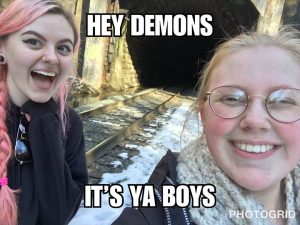
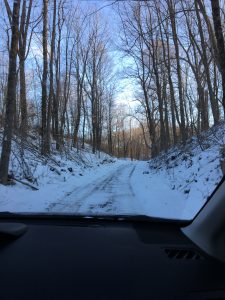

 Walking up to the tunnel, the West Portal to be exact, was not as “creepy” as I had expected. Looking back on the moment I feel like that may have been because of the snow that covered everything in the area. It’s hard to understand just how large the tunnel is until you’re standing at the entrance. It becomes even clearer when you see someone else standing at the entrance (especially someone as tall as Erica). The tunnel was decorated in graffiti and a common tag found locally: “you’re going to be ok” was just on the outside of the tunnel. The inside of the tunnel looked unwelcoming. The snow itself didn’t dare to venture inside the endless darkness. The entire area seemed abandoned and silent.
Walking up to the tunnel, the West Portal to be exact, was not as “creepy” as I had expected. Looking back on the moment I feel like that may have been because of the snow that covered everything in the area. It’s hard to understand just how large the tunnel is until you’re standing at the entrance. It becomes even clearer when you see someone else standing at the entrance (especially someone as tall as Erica). The tunnel was decorated in graffiti and a common tag found locally: “you’re going to be ok” was just on the outside of the tunnel. The inside of the tunnel looked unwelcoming. The snow itself didn’t dare to venture inside the endless darkness. The entire area seemed abandoned and silent. Unexpectedly, we found that the closer we got to the tunnel, the warmer it got. I have had friends describe the tunnel to me beforehand and everyone always describes the tunnel as freezing, especially in the winter. The air seemed to stand still beside the tunnel. Maybe it was the history of deaths in the “Bloody Pit” (as the tunnel is sometimes referred to) that added to the eerie feeling while standing just outside. But the longer I stood there, the more I was able to dismiss that uneasy feeling and enjoy exploring the outside of the tunnel, making excited remarks about the most unexciting things: the track wasn’t directly in the middle of the tunnel but closer to the side, closer to the small stream. Why?
Unexpectedly, we found that the closer we got to the tunnel, the warmer it got. I have had friends describe the tunnel to me beforehand and everyone always describes the tunnel as freezing, especially in the winter. The air seemed to stand still beside the tunnel. Maybe it was the history of deaths in the “Bloody Pit” (as the tunnel is sometimes referred to) that added to the eerie feeling while standing just outside. But the longer I stood there, the more I was able to dismiss that uneasy feeling and enjoy exploring the outside of the tunnel, making excited remarks about the most unexciting things: the track wasn’t directly in the middle of the tunnel but closer to the side, closer to the small stream. Why? We decided to backtrack before stopping by the building near the car. There was a brick building falling apart just above the tracks. Was this where they originally tried to bore into the mountain? There was a hole filled with dirt. It looked like there were tracks on the ground, but maybe not. The corner of the roof was missing (More excited remarks about unexciting things: “Wow! The corner is missing!”) I have no idea what this place was actually used for. Maybe it was built over the original site and then was used for other purposes later on? I’m really unsure of what to think about it as of right now.
We decided to backtrack before stopping by the building near the car. There was a brick building falling apart just above the tracks. Was this where they originally tried to bore into the mountain? There was a hole filled with dirt. It looked like there were tracks on the ground, but maybe not. The corner of the roof was missing (More excited remarks about unexciting things: “Wow! The corner is missing!”) I have no idea what this place was actually used for. Maybe it was built over the original site and then was used for other purposes later on? I’m really unsure of what to think about it as of right now. Between the two unknown buildings: beavers. I have never felt so excited about beavers before in my life. We didn’t actually see a beaver, but after identifying a tree that was clearly gnawed on, we ran back and realized we had walked right past a dam without noticing it was even there. I don’t know what it was about that particular experience that made it so exciting when we didn’t even see a beaver. I had seen a beaver walking down my street once before and didn’t think anything of it. But here I was, jumping like I was having the time of my life (I was), pointing at the dam repeatedly.
Between the two unknown buildings: beavers. I have never felt so excited about beavers before in my life. We didn’t actually see a beaver, but after identifying a tree that was clearly gnawed on, we ran back and realized we had walked right past a dam without noticing it was even there. I don’t know what it was about that particular experience that made it so exciting when we didn’t even see a beaver. I had seen a beaver walking down my street once before and didn’t think anything of it. But here I was, jumping like I was having the time of my life (I was), pointing at the dam repeatedly.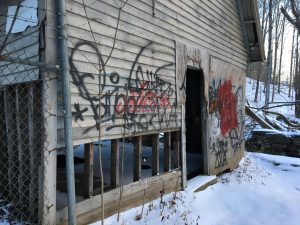
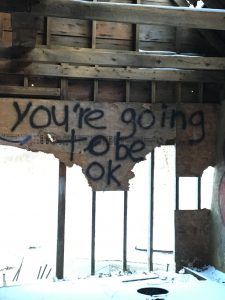 We took a look into this smaller structure, and the first thing we see: “you’re going to be ok” again. This area feels secluded from the rest of town, but the tag reminds us of where we are, that even though we aren’t surrounded by people, people have been here and people will be here (just as we were). Despite the graffiti in the three locations in this area, there were no piles of litter that we could see, and the area did not look like it had been utterly destroyed by people visiting. I hope the snow melts by the time we visit the tunnel again so we can take a closer look at the area.
We took a look into this smaller structure, and the first thing we see: “you’re going to be ok” again. This area feels secluded from the rest of town, but the tag reminds us of where we are, that even though we aren’t surrounded by people, people have been here and people will be here (just as we were). Despite the graffiti in the three locations in this area, there were no piles of litter that we could see, and the area did not look like it had been utterly destroyed by people visiting. I hope the snow melts by the time we visit the tunnel again so we can take a closer look at the area.